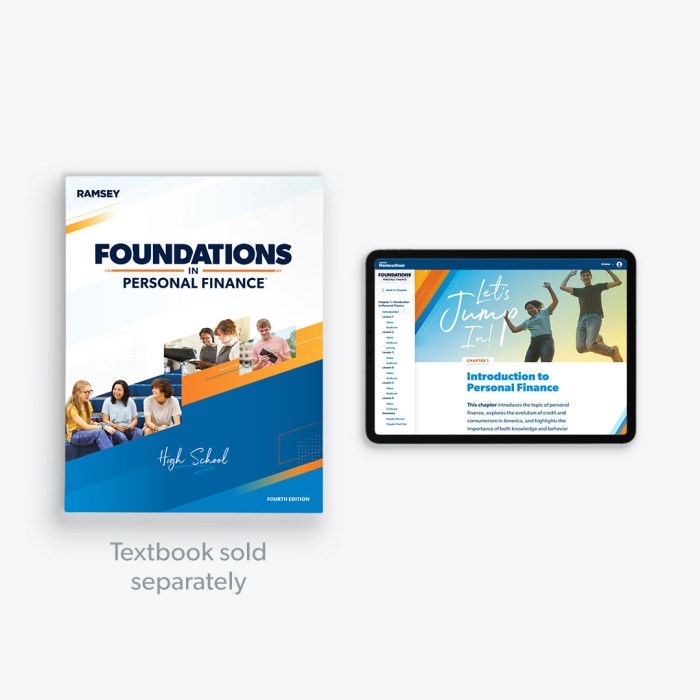Embarking on a journey of financial literacy, Foundations in Personal Finance Homeschool Edition unveils the intricacies of money management, empowering homeschoolers with the knowledge and skills to navigate the complexities of personal finance throughout their lives.
This comprehensive guide delves into fundamental financial concepts, exploring the nuances of budgeting, saving, investing, credit, debt, insurance, and risk management. By fostering a deep understanding of these pillars, homeschoolers gain the confidence to make informed financial decisions, secure their financial futures, and achieve their long-term financial goals.
Understanding Financial Concepts

Personal finance is the management of individual financial resources. It involves understanding how to earn, spend, save, and invest money. The fundamentals of money management include budgeting, tracking expenses, and understanding different types of financial accounts. Budgeting helps individuals allocate their income to different categories of expenses, ensuring that they live within their means.
Tracking expenses provides insights into spending patterns, enabling individuals to identify areas where they can save money. Financial accounts, such as checking accounts, savings accounts, and investment accounts, serve different purposes and offer varying levels of liquidity and interest rates.
Types of Financial Accounts
- Checking accounts: For everyday transactions, such as writing checks, making debit card purchases, and paying bills.
- Savings accounts: For short-term savings goals, such as an emergency fund or a down payment on a car.
- Investment accounts: For long-term financial goals, such as retirement or a child’s education, and offer higher potential returns but also carry more risk.
Importance of Budgeting and Tracking Expenses
Budgeting helps individuals control their spending, avoid debt, and reach their financial goals. By creating a budget, individuals can allocate their income to essential expenses, such as housing, food, and transportation, as well as to savings and discretionary spending. Tracking expenses allows individuals to monitor their spending habits, identify areas where they can save money, and make informed financial decisions.
Saving and Investing
Saving and investing are essential components of personal finance. Saving involves setting aside a portion of income for future use, while investing involves using saved funds to generate income or capital appreciation. Effective saving strategies include setting up a regular savings plan, automating transfers to a savings account, and reducing unnecessary expenses.
Investment Options
- Stocks: Represent ownership in a company and offer potential for capital appreciation but also carry higher risk.
- Bonds: Represent loans made to companies or governments and offer fixed interest payments but typically lower returns.
- Mutual funds: Diversified baskets of stocks or bonds that provide exposure to a range of investments and reduce risk.
- Exchange-traded funds (ETFs): Similar to mutual funds, but traded on stock exchanges like stocks.
Risks and Rewards of Investing
All investments carry some level of risk. Stocks are considered higher risk but have the potential for higher returns, while bonds are considered lower risk but offer lower returns. Diversification, which involves investing in a mix of different assets, can help reduce risk.
The risk tolerance of an individual should be considered when making investment decisions.
Role of Compound Interest in Wealth Accumulation
Compound interest is the interest earned on both the principal amount and the accumulated interest. Over time, compound interest can significantly increase the value of investments. Regular contributions and long-term investing can harness the power of compound interest to build wealth.
Credit and Debt: Foundations In Personal Finance Homeschool Edition

Credit is the ability to borrow money and repay it later. Responsible use of credit can help individuals make large purchases, such as a car or a house, and build a positive credit history. However, excessive debt can lead to financial distress and damage credit scores.
Using Credit Responsibly
- Only borrow what you can afford to repay.
- Compare interest rates and fees from different lenders.
- Make payments on time and in full.
- Avoid maxing out credit cards.
Consequences of Excessive Debt
- High interest charges and late fees.
- Damaged credit score, making it harder to qualify for future loans.
- Wage garnishment or asset seizure in severe cases.
Strategies for Debt Management
- Create a debt repayment plan.
- Consolidate debts into a single loan with a lower interest rate.
- Seek credit counseling if necessary.
Planning for the Future

Financial planning is crucial for different life stages. Retirement planning involves saving and investing for the future to ensure financial security in old age. Estate planning involves distributing assets and minimizing taxes after death.
Retirement Planning
- Start saving early and contribute regularly to retirement accounts.
- Consider employer-sponsored retirement plans, such as 401(k)s and IRAs.
- Estimate retirement expenses and adjust savings goals accordingly.
Estate Planning
- Create a will or trust to distribute assets after death.
- Consider life insurance to provide for dependents.
- Minimize estate taxes through tax-advantaged accounts and trusts.
Insurance and Risk Management

Insurance is a way to protect against financial losses due to unexpected events. Risk management involves assessing potential risks and implementing strategies to mitigate them.
Types of Insurance Coverage
- Health insurance: Covers medical expenses.
- Homeowners or renters insurance: Protects property from damage or loss.
- Auto insurance: Covers vehicles and provides liability protection.
- Life insurance: Provides financial support to dependents in case of death.
Assessing Risk and Determining Insurance Needs
Individuals should assess their risk exposure and determine appropriate insurance coverage. Factors to consider include age, health, occupation, property value, and financial situation. Insurance policies should provide adequate coverage without overpaying for unnecessary protection.
Protecting Assets and Income
Insurance plays a crucial role in protecting assets and income. Health insurance ensures access to healthcare without facing financial ruin. Homeowners insurance protects against property damage or loss, while auto insurance provides liability protection in case of accidents. Life insurance provides financial support to dependents and helps preserve wealth.
Financial Decision-Making
Financial decision-making involves making informed choices about money management. Cognitive biases can influence financial decisions, leading to irrational or suboptimal choices.
Cognitive Biases
- Confirmation bias: Seeking information that confirms existing beliefs.
- Loss aversion: Tendency to feel the pain of losses more strongly than the pleasure of gains.
- Framing effect: How information is presented can influence decisions.
Strategies for Sound Financial Decisions
- Be aware of cognitive biases.
- Gather objective information and consult multiple sources.
- Consider long-term consequences and opportunity costs.
- Seek professional financial advice when needed.
Importance of Seeking Professional Financial Advice, Foundations in personal finance homeschool edition
In complex financial situations or when facing major financial decisions, seeking professional financial advice can be beneficial. Financial advisors can provide personalized guidance, help individuals navigate financial markets, and develop strategies to meet their specific financial goals.
User Queries
What are the key financial concepts covered in this guide?
This guide encompasses a comprehensive range of financial concepts, including budgeting, saving, investing, credit, debt, insurance, and risk management, providing a holistic understanding of personal finance.
How does this guide benefit homeschoolers specifically?
Tailored to the unique needs of homeschoolers, this guide aligns with their flexible learning schedules and provides a comprehensive curriculum that empowers them to develop essential financial literacy skills at their own pace.
What makes this guide an effective tool for financial education?
This guide stands out as an effective tool for financial education due to its engaging and accessible approach, relatable examples, interactive exercises, and emphasis on practical application, fostering a deep understanding of financial principles.